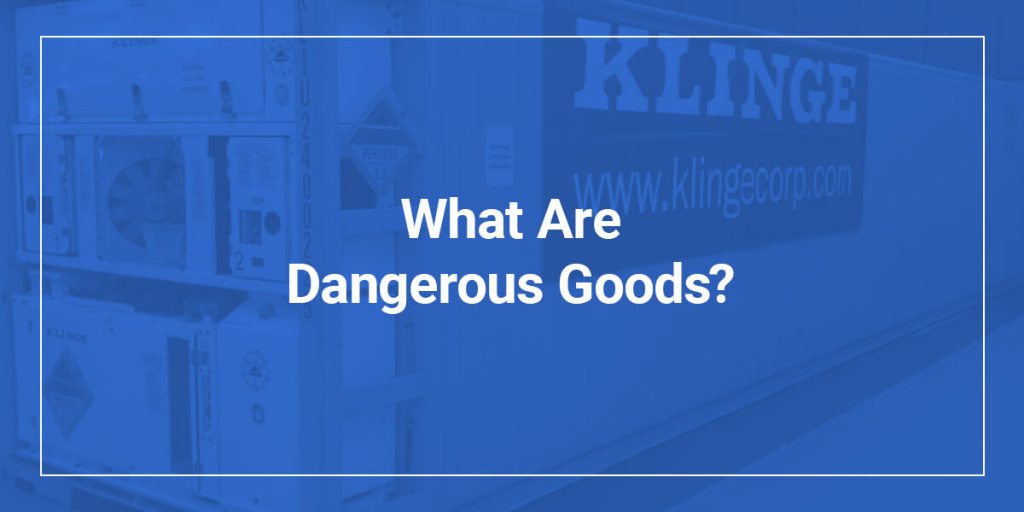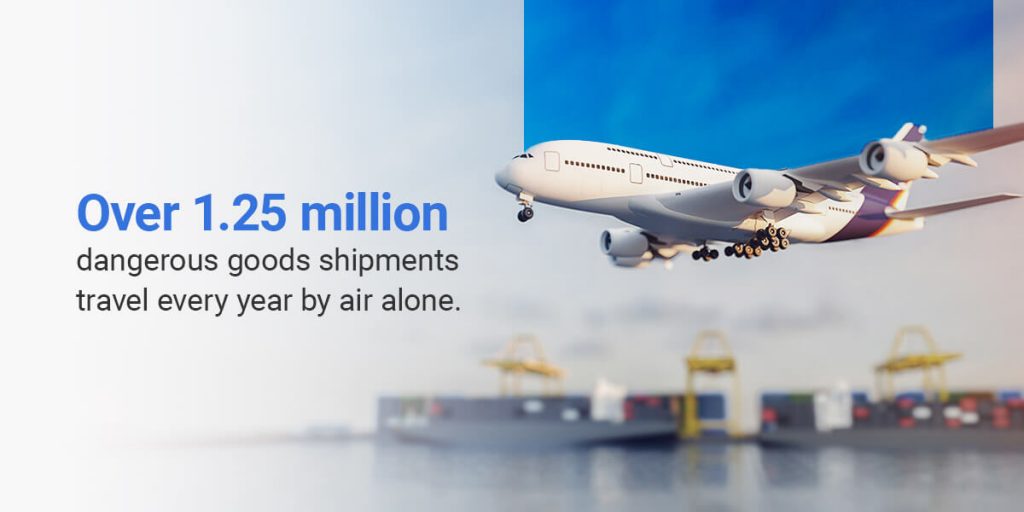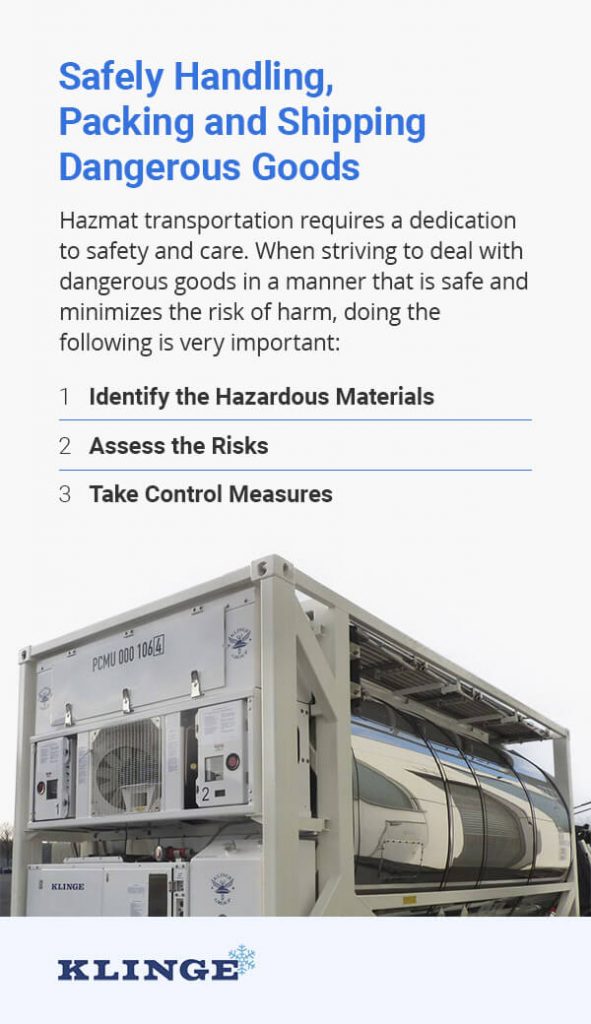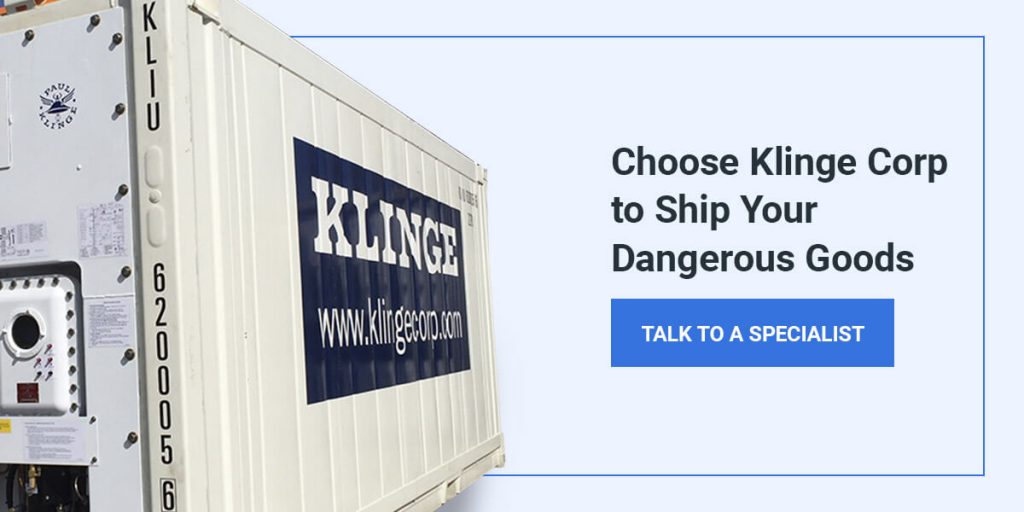
As consumers, we unknowingly utilize dangerous goods on a daily basis. Many products fit into the category of dangerous goods, from the toothpaste in your bathroom to the aerosol whipped cream in your refrigerator. These same goods require special care during transportation to prevent dangerous situations.
Factors ranging from vibration to static electricity can contribute to disruptions and risks associated with moving hazardous materials. Learn more below about dangerous goods and the processes that ensure transportation safety.
What Are Considered Dangerous Goods?
Dangerous goods refer to any material that poses potential risks to human health, property or environmental health. These goods are also known as hazardous materials or hazmats. From storage to shipping, handling dangerous goods requires proper precautions to maintain the safety of both people and places.

You can transport hazmat via planes, trains, ships or land vehicles. Over 1.25 million dangerous goods shipments travel every year by air alone. With millions of these products moving around the world in various modes of transportation, safely dealing with hazardous materials is crucial to ensuring the people, property and environment on the travel route are not in harm’s way.
You may be surprised to learn how broad the scope of dangerous goods is. Here are just a few of the hazardous materials that need to ship throughout the country and the world:
- Household cleaning products
- Spray lubricants
- Nail polish remover
- Aerosol cans
- Dry ice
- Matches
- Propane
- Bleach
- Gasoline
- Lithium batteries
- Chlorine
- Glue
- Resins
- Disinfectants
- Fertilizers
- Vaccines
These materials can pose a serious risk during transportation. Factors such as temperature and pressure can lead to dangerous situations, including:
- Explosions
- Fires
- Leaks
- Poisonous fumes
- Compressed gases
- Radioactive radiation
- Corrosion
It is vital for those involved in the shipping and handling processes of hazardous materials to take the proper precautions and follow protocol to avoid these unsafe scenarios. These workers include those who:
- Load and unload dangerous goods.
- Work closely with these materials during the manufacturing process.
- Package these items.
- Prepare hazmat for transportation.
- Drive vehicles hauling hazardous materials.
How Many Classes of Dangerous Goods Are There?
There are nine classes of hazardous materials that all encompass different characteristics and risks. Some of these primary categories also include subdivisions. Identifying which class a dangerous good falls into is essential for the identifying and marking processes.
Class 1: Explosives
The first classification of dangerous goods includes devices or chemicals that could explode or combust under certain conditions. Handling this class requires extreme caution and care to minimize safety risks.
Class 1 includes six subdivisions ranging from mass explosives to extremely insensitive dangerous goods. Here are some of the examples of the types of explosives from various subdivisions of Class 1:
- Pyrotechnics and fireworks
- TNT
- Sparklers
- Grenades
Class 2: Gases
The second classification of dangerous goods encompasses gases in various forms, including liquefied, refrigerated and compressed. Class 2 is dangerous because these gases can explode under pressure, and some can potentially result in fire.
This class includes three subdivisions:
- Flammable gases
- Non-flammable, non-toxic gases
- Toxic gases
Some common examples of Class 2 include:
- Lighters
- Oxygen
- Natural gas
- Aerosols
- Carbon dioxide
- Propane
- Helium
- Nitrogen
- Chlorine
Class 3: Flammable Liquids
Class 3 encompasses flammable liquids with flash points below 60 degrees Celsius (140 F), including liquid and molten solid substances as well as liquid desensitized explosives. There are no subdivisions of Class 3.
We frequently utilize goods from this class in our daily lives. The following are examples of flammable liquids in this group:
- Alcohol
- Nail polish
- Ethanol
- Acetone
- Paint
- Kerosene
- Petrol
Class 4: Flammable Solids, Spontaneously Combustible and Dangerous When Wet
The fourth class of dangerous goods actually encompasses three categories, reflected in Class 4’s subdivisions:
- Flammable solids
- Spontaneously combustible solids
- Solids that are dangerous when wet
This class of dangerous goods can cause a fire or give off toxic gas through friction, ignition or contact with water. Some of the common examples of Class 4 hazardous materials include:
- Activated Carbon
- Sulfur
- Alkali metals
- Matches
- Zinc dust
Class 5: Oxidizers and Organic Peroxides
Class 5 includes dangerous goods that fall into two subdivisions — oxidizing agents and organic peroxides.
Oxidizers can be very reactive materials because of their high oxygen content and some goods in this category can become explosive at higher temperatures. Organic peroxides are susceptible to ignition and often require refrigeration to control their temperature and avoid fire or explosions.
The following are some examples of Class 5 dangerous goods:
- Sodium nitrate
- Fertilizers
- Oxygen generators
- Hydrogen peroxide
- Benzoyl peroxide
Class 6: Poisons, Poison Inhalation Hazards and Infectious Substances
The sixth class of dangerous goods covers both toxic and infectious substances in its subdivisions. Toxic substances can be extremely harmful when inhaled, absorbed or ingested. They can cause serious illness and, in severe cases, lead to death. Infectious substances include any hazmat that contains microorganisms that can cause disease in animals and humans.
Examples of Class 6 include:
- Arsenic
- Snake venom
- Rodent poison
- Chloroform
- Clinical specimens
Class 7: Radioactive Material
Class 7 dangerous goods include any radioactive materials, encompassing three different category labels depending on the radioactive content and activity. Radioactive materials can cause harm through contamination, heat or radiation.
The following are some common examples of radioactive material in this class:
- Radioactive ores
- Isotopes
- Density gauges
- Medical equipment
- Uranium
- Static eliminators
Class 8: Corrosives
Class 8 dangerous goods encompass corrosive materials that can cause harm through:
- Damage to living tissue.
- Chemical destruction.
- Reactions between acids and alkalis leading to fires, explosions or toxic and corrosive gas emissions.
Here are some examples of Class 8 dangerous goods:
- Hydrochloric acid
- Mercury
- Quicklime
- Sodium hypochlorite
- Battery fluid
- Sulfuric acid
Class 9: Miscellaneous Hazardous Materials
The final class of dangerous goods accounts for miscellaneous hazardous materials not included in the previous eight categories. This group of hazmats consists of:
- Environmentally hazardous materials.
- Magnetized materials.
- Substances transported at high temperatures.
- Genetically modified organisms and microorganisms.
Beyond these goods, Class 9 encompasses additional substances that the aviation industry regulates, including lithium-ion batteries, airbag modules and zinc oxide.
What Is the Most Hazardous Class?
While every group of dangerous goods has its own risks, Class 1 is the most hazardous and has the potential of all nine classes to do the most damage to human and animal life.
Identifying Dangerous Goods
Identifying hazmat aims to assign proper United Nations (U.N.) dangerous goods numbers and shipping names that coincide with their class and properties. U.N. numbers are an internationally recognized system for identifying hazardous materials for shipping via air, land or sea. There are over 3,500 registered four-digit U.N. numbers, ranging from U.N. 0004 through U.N. 3548. Accurately identifying the U.N. number of hazardous mixtures and other substances requires an expert.
U.N. numbers help establish the consistency necessary to keep international organizations on the same page. Accurate identification allows those working closely with hazmat to complete their jobs safely and be more aware of what materials they are handling.

Employees who work to identify and classify dangerous goods require specialty training to understand every aspect of the transportation process. These employees may need to include additional descriptive words when assigning U.N. numbers to mark certain dangerous goods. For example, adding the word “Waste” or Stabilized” to identifying numbers is necessary to note those specific properties. Other qualifying words ensure dangerous goods are adequately labeled.
Marking and Labeling of Dangerous Goods
The Pipeline and Hazardous Materials Safety Administration (PHMSA), a division of the United States Department of Transportation (DOT), outlines regulations and requirements for markings and labels of dangerous goods. The Occupational Safety and Health Administration (OSHA) enforces these regulations.
Marking and labeling are equally important for your shipment of dangerous goods. Both processes are both essential parts of preparing and packaging these materials for transportation.
Marking
To help prevent spills, accidents and exposure, markings for dangerous goods must include their:
- Descriptive name
- Identification number
- U.N. number
- Cautions
- Weight
- Specifications
These markings must comply with regulations that ensure they are clear and helpful for those handling dangerous goods. Any markings must be:
- Durable.
- In English.
- Printed or affixed to the package.
- Displayed on a background of contrasting color.
- Unobscured by other labels and attachments.
- Separate from other markings that could lessen its impact.
Labeling
In addition to marking, it is vital that those looking to ship dangerous goods also abide by proper labeling practices. The purpose of these labels is to communicate the hazards within the package clearly.
The labeling regulations in 49 CFR 172.400 of the Code of Federal Regulations include rules for using codes, colors and pictograms to communicate the contents of the package. As with markings, all labels must be affixed or printed directly on the surface of the package containing dangerous goods.
Certifications for Dealing With Dangerous Goods
Specialized training programs help further ensure the safety of those handling hazardous materials. Every stage requires trained and skilled individuals, from packing to monitoring hazmat movement.
Hazmat certifications aim to guard the movement of dangerous goods against preventable hazards that may impact people, property or the environment. With proper training, those who work with dangerous goods can reduce the risk of harm and prevent regulation violations.
There are three main categories of certifications when it comes to dealing with the logistics of dangerous goods:
Transportation Management
The transportation process involves numerous points that require approval from a certified worker. Individuals can earn certifications for managing the transportation of hazardous materials.
Managing hazmat movement is a rigorous process that involves inspecting and evaluating different aspects of travel, including:
- Ensuring the packaging has adequate labels.
- Choosing the right transportation method.
- Checking the packaging’s safety and security.
Inspection
Even the smallest leak or sign of damage can be detrimental when handling dangerous goods. It is essential to have extensive inspection points throughout the traveling process. With such a significant need, there is a high demand for individuals with the credentials to inspect dangerous goods.
Storage and Warehousing
Hazmat requires warehousing specifically designed to store the packaging safely, which makes storing dangerous goods another vital area for certification.
Storing and warehousing dangerous goods requires extensive knowledge of hazmat storage regulations. Teams that utilize this type of storage should have special certifications to maintain warehouse safety.

Safely Handling, Packing and Shipping Dangerous Goods
Hazmat transportation requires a dedication to safety and care. When striving to deal with dangerous goods in a manner that is safe and minimizes the risk of harm, doing the following is very important:
1. Identify the Hazardous Materials
The first step in safely handling and packaging dangerous goods is correctly identifying the hazardous materials.
By clearly marking and labeling dangerous goods, you can help reduce the likelihood of an accident or mishap throughout the transportation process. Incorporating the necessary markings and labels is essential to helping everyone involved in shipping and handling know what they’re working with and how to proceed safely.
2. Assess the Risks
The next stage of safely dealing with dangerous goods is risk assessment. Evaluate the likelihood of a mishap that could lead to injury or illness as well as how harmful that incident may be. Consider what factors contribute to these risks and what you can put in place to avoid danger to people or the environment.
3. Take Control Measures
Control measures fall into two main groups. The first group encompasses actions teams must take to comply with official regulations and requirements. The second group involves additional measures that may not be legally required but will help eliminate as many risks as possible. Both types of control measures are essential to transport hazardous materials safely.
Control measures include:
- Having proper ventilation.
- Storing fewer quantities.
- Having on-site security.
- Performing regular inspections and maintenance.
By taking these steps, you can safely transport dangerous goods and minimize the associated risks.

Choose Klinge Corp to Ship Your Dangerous Goods
Klinge Corporation is a leading designer and manufacturer of specialized transport equipment with over 40 years of experience. If you need to ship or store dangerous goods, we have the containers you need to keep your goods safe in transport.
Our business prides itself on providing tailored, innovative products. We utilize extensive research and development to create high-quality results that meet our clients’ specialized needs.
Are you interested in learning more about shipping your dangerous goods with Klinge Corporation? Talk to a specialist or request a quote today!
